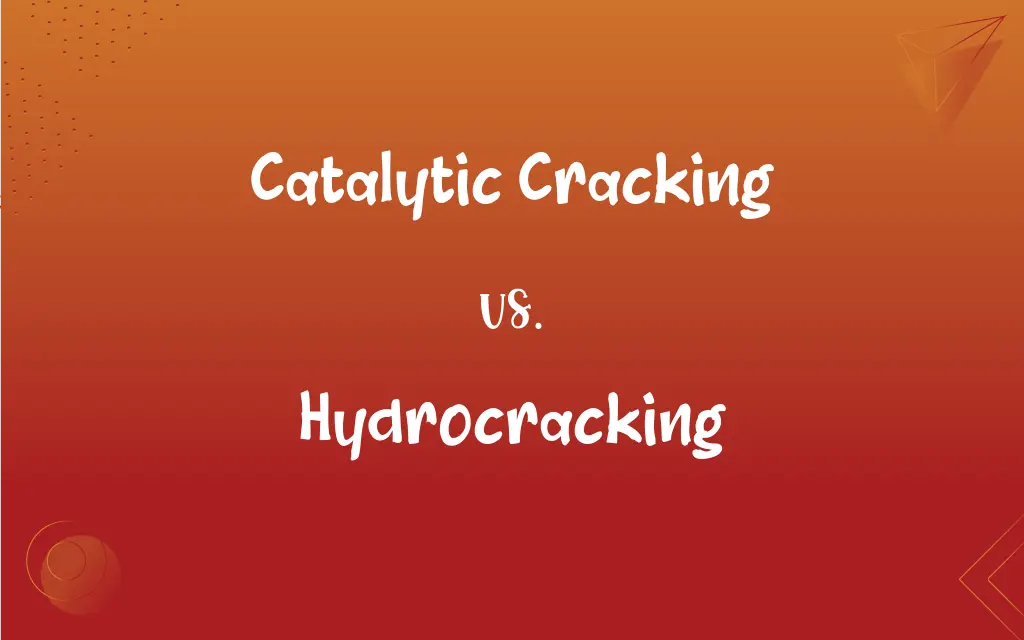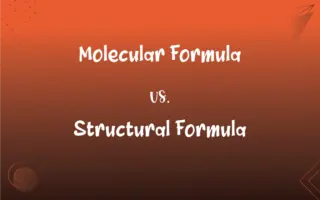Catalytic Cracking vs. Hydrocracking: What's the Difference?
Edited by Harlon Moss || By Janet White || Published on December 21, 2023
Catalytic cracking breaks heavy hydrocarbons using catalysts, primarily for gasoline; hydrocracking adds hydrogen, targeting diesel and jet fuel.

Key Differences
Catalytic cracking, a key process in petroleum refineries, involves breaking down large hydrocarbon molecules into smaller ones using a catalyst. This method primarily produces gasoline and lighter compounds. In contrast, hydrocracking, also a refining process, combines cracking with the addition of hydrogen. It's designed not just to break down large molecules but also to saturate them with hydrogen, typically yielding higher quantities of diesel and jet fuel.
The catalysts used in catalytic cracking are typically solid acids that facilitate the breaking of carbon-carbon bonds in heavy hydrocarbons. This results in the production of lighter, more valuable fractions like gasoline and propylene. Hydrocracking, on the other hand, employs a different type of catalyst, usually containing a metal such as nickel or molybdenum, which aids in both cracking and hydrogenation. This dual function allows hydrocracking to produce not only lighter fractions but also more hydrogen-saturated and cleaner fuels.
In terms of environmental impact, catalytic cracking can lead to the formation of more olefins and aromatic compounds, which are precursors to pollutants. However, it's efficient for maximizing gasoline production. Hydrocracking, while producing less gasoline, generates fuels with lower sulfur content and higher cetane numbers, making it a cleaner process suitable for producing diesel and jet fuels that meet stringent environmental regulations.
Operational conditions differ significantly between the two processes. Catalytic cracking operates at lower hydrogen pressures and higher temperatures, optimizing the yield of gasoline. Hydrocracking requires higher hydrogen pressures and moderate temperatures, which are essential for hydrogenation and producing middle-distillate fuels like diesel.
The choice between catalytic cracking and hydrocracking often depends on market demand. Catalytic cracking is favored when there is a high demand for gasoline, while hydrocracking is preferred in markets where diesel and jet fuel are in greater demand. This reflects the flexibility of refineries in adapting to changing fuel requirements.
ADVERTISEMENT
Comparison Chart
Primary Products
Gasoline, lighter hydrocarbons
Diesel, jet fuel, cleaner fuels
Catalysts
Solid acids
Metals like nickel or molybdenum
Environmental Impact
More olefins, aromatics
Lower sulfur content, cleaner emissions
Operational Conditions
Lower hydrogen pressure, higher temp.
Higher hydrogen pressure, moderate temp.
Market Preference
Favored for high gasoline demand
Preferred for diesel, jet fuel demand
ADVERTISEMENT
Catalytic Cracking and Hydrocracking Definitions
Catalytic Cracking
It's a method to produce lighter petroleum products like gasoline from heavy crude oil fractions.
Catalytic cracking plays a crucial role in converting heavy oil into consumer-ready gasoline.
Hydrocracking
Hydrocracking is a refining process that breaks and hydrogenates heavy hydrocarbons to produce cleaner fuels.
The refinery's hydrocracking unit was pivotal in increasing its diesel fuel production.
Catalytic Cracking
Catalytic cracking is a refining process breaking down large hydrocarbons into smaller ones using catalysts.
The refinery increased its gasoline output by optimizing its catalytic cracking unit.
Hydrocracking
This process is ideal for producing fuels that meet stringent environmental standards, like low-sulfur diesel.
Hydrocracking's ability to produce eco-friendly fuels has made it a key process in modern refineries.
Catalytic Cracking
Catalytic cracking transforms heavy, less valuable hydrocarbon fractions into lighter, more valuable ones.
Refineries rely on catalytic cracking to increase the yield of high-value products from crude oil.
Hydrocracking
Hydrocracking uses catalysts and high hydrogen pressure to saturate hydrocarbons, producing lower-sulfur fuels.
Environmental regulations have prompted refineries to invest more in hydrocracking technology.
Catalytic Cracking
Catalytic cracking involves using solid acid catalysts to facilitate the breakdown of heavy hydrocarbons.
The efficiency of catalytic cracking depends largely on the effectiveness of the catalysts used.
Hydrocracking
It combines cracking with hydrogen addition, yielding diesel, jet fuel, and other middle-distillates.
Hydrocracking has gained popularity due to its ability to produce high-quality diesel.
Catalytic Cracking
This process maximizes gasoline production from crude oil in refineries.
Catalytic cracking is essential in meeting the high demand for gasoline in the market.
Hydrocracking
Hydrocracking adjusts the hydrogen content in heavy hydrocarbons, making it essential for cleaner fuel production.
The shift towards cleaner fuels has increased the importance of hydrocracking in the refining industry.
Hydrocracking
A process by which the hydrocarbon molecules of petroleum are broken into simpler molecules, as of gasoline or kerosene, by the addition of hydrogen under high pressure and in the presence of a catalyst.
Hydrocracking
(organic chemistry) the production of high-octane petroleum fuel and kerosene by hydrogenating large or complex hydrocarbons and then cracking them.
Hydrocracking
Present participle of hydrocrack
Hydrocracking
The process whereby hydrocarbon molecules of petroleum are broken down into kerosene and gasolene by the addition of hydrogen under high pressure in the presence of a catalyst
FAQs
What are the main products of catalytic cracking?
The primary products are gasoline and lighter hydrocarbons.
What catalysts are used in catalytic cracking?
Solid acid catalysts are typically used in catalytic cracking.
What is catalytic cracking?
It's a petroleum refining process that breaks down large hydrocarbon molecules into smaller ones using catalysts.
What environmental impacts does catalytic cracking have?
It can lead to more olefins and aromatics, which are pollutants.
What catalysts are used in hydrocracking?
Catalysts in hydrocracking usually contain metals like nickel or molybdenum.
How does market demand influence the choice between these two processes?
Catalytic cracking is preferred for high gasoline demand, while hydrocracking is chosen for diesel and jet fuel demand.
What role does hydrogen play in hydrocracking?
Hydrogen in hydrocracking helps saturate hydrocarbons, improving fuel quality.
What operational conditions are required for hydrocracking?
It requires higher hydrogen pressures and moderate temperatures.
Why is hydrocracking environmentally significant?
It produces fuels with lower sulfur content and higher cetane numbers, resulting in cleaner emissions.
Is catalytic cracking more efficient for gasoline production?
Yes, it's more efficient for gasoline production compared to hydrocracking.
Why is catalytic cracking important?
It maximizes gasoline production and transforms heavy oil fractions into valuable products.
Can both processes coexist in a refinery?
Yes, many refineries use both processes to meet diverse fuel demands.
Can hydrocracking produce gasoline?
While it can produce gasoline, hydrocracking is more focused on diesel and jet fuel.
Does catalytic cracking require high temperatures?
Yes, it operates at higher temperatures compared to hydrocracking.
What type of crude oil is best suited for catalytic cracking?
Heavier crude oil fractions are more suitable for catalytic cracking.
How does hydrocracking contribute to meeting environmental standards?
By producing low-sulfur diesel and cleaner jet fuel, it helps meet stringent environmental regulations.
What is hydrocracking?
Hydrocracking is a refining process combining cracking with hydrogen addition, primarily producing diesel and jet fuel.
How does hydrocracking differ from catalytic cracking?
Hydrocracking adds hydrogen to the process, producing cleaner fuels with lower sulfur content.
Can catalytic cracking and hydrocracking be modified for better efficiency?
Yes, ongoing research and technological advancements aim to improve the efficiency and environmental impact of both processes.
Are the products of hydrocracking cleaner than those from catalytic cracking?
Generally, hydrocracking produces cleaner fuels due to lower sulfur content.
About Author
Written by
Janet WhiteJanet White has been an esteemed writer and blogger for Difference Wiki. Holding a Master's degree in Science and Medical Journalism from the prestigious Boston University, she has consistently demonstrated her expertise and passion for her field. When she's not immersed in her work, Janet relishes her time exercising, delving into a good book, and cherishing moments with friends and family.
Edited by
Harlon MossHarlon is a seasoned quality moderator and accomplished content writer for Difference Wiki. An alumnus of the prestigious University of California, he earned his degree in Computer Science. Leveraging his academic background, Harlon brings a meticulous and informed perspective to his work, ensuring content accuracy and excellence.































































